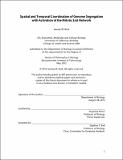| dc.contributor.advisor | Angelika Amon. | en_US |
| dc.contributor.author | Rock, Jeremy M. (Jeremy Michael) | en_US |
| dc.contributor.other | Massachusetts Institute of Technology. Dept. of Biology. | en_US |
| dc.date.accessioned | 2013-03-13T15:24:37Z | |
| dc.date.available | 2013-03-13T15:24:37Z | |
| dc.date.copyright | 2012 | en_US |
| dc.date.issued | 2012 | en_US |
| dc.identifier.uri | http://hdl.handle.net/1721.1/77639 | |
| dc.description | Thesis (Ph. D.)--Massachusetts Institute of Technology, Dept. of Biology, 2012. | en_US |
| dc.description | This electronic version was submitted by the student author. The certified thesis is available in the Institute Archives and Special Collections. | en_US |
| dc.description | Cataloged from student-submitted PDF version of thesis. | en_US |
| dc.description | Includes bibliographical references. | en_US |
| dc.description.abstract | In budding yeast, an essential Hippo-like signal transduction cascade known as the Mitotic Exit Network (MEN) governs the final cell cycle transition, the mitosis to G1 transition. To ensure the accurate execution of mitosis, MEN activity is coordinated with other cellular events. The work presented in this thesis elucidates the coordination of genome segregation with MEN activation. We first identified a novel essential role for Polo kinase Cdc5 in MEN activation. Cdc5 functions in parallel to the GTPase Tem1 to recruit the MEN kinase Cdc15 to SPBs, which is both necessary and sufficient for MEN signaling. This work thus defined Cdc15 as a coincidence detector of two essential cell cycle oscillators: the Polo kinase Cdc5 synthesis/degradation cycle and the Tem1 G-protein cycle. The Cdc15-dependent integration of these temporal (Cdc5 and Tem1 activity) and spatial (Tem1 activity) signals ensures that exit from mitosis occurs only after proper genome partitioning. Finally, we characterize the role of the scaffold Nud1 in the assembly of active MEN signaling complexes at spindle pole bodies (SPBs). We found that the assembly of such complexes requires the phosphorylation of the MEN scaffold Nud1. Phosphorylation of Nud1 in mitosis is essential for the SPB recruitment of terminal MEN kinase Dbf2 and its coactivator Mob1. We further show that the Hippo-like kinase Cdc15 phosphorylates Nud1. Finally, we present evidence that Mob1 is a novel class of phosphopeptide binding domains. Thus, Cdc15-dependent phosphorylation of the scaffold Nud1 creates a docking site for the Mob1 coactivator, thereby resulting in the recruitment of Dbf2 to SPBs and firing of the MEN. | en_US |
| dc.description.statementofresponsibility | by Jeremy M. Rock. | en_US |
| dc.format.extent | 221 p. | en_US |
| dc.language.iso | eng | en_US |
| dc.publisher | Massachusetts Institute of Technology | en_US |
| dc.rights | M.I.T. theses are protected by
copyright. They may be viewed from this source for any purpose, but
reproduction or distribution in any format is prohibited without written
permission. See provided URL for inquiries about permission. | en_US |
| dc.rights.uri | http://dspace.mit.edu/handle/1721.1/7582 | en_US |
| dc.subject | Biology. | en_US |
| dc.title | Spatial and temporal coordination of genome segregation with activation of the Mitotic Exit Network | en_US |
| dc.type | Thesis | en_US |
| dc.description.degree | Ph.D. | en_US |
| dc.contributor.department | Massachusetts Institute of Technology. Department of Biology | |
| dc.identifier.oclc | 827830581 | en_US |
